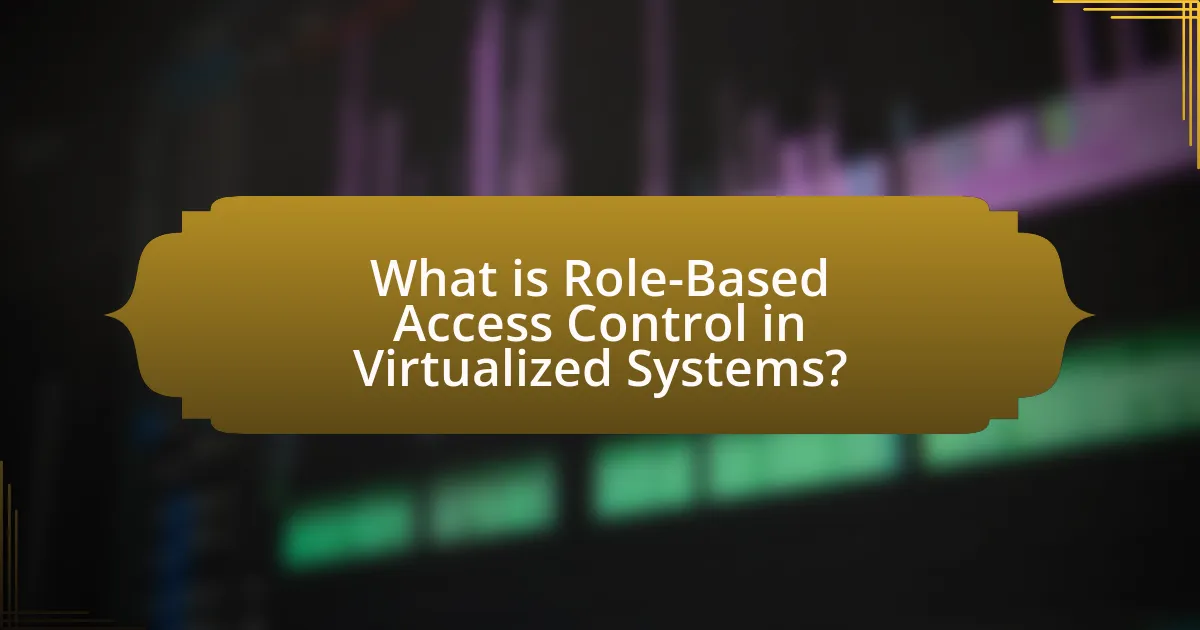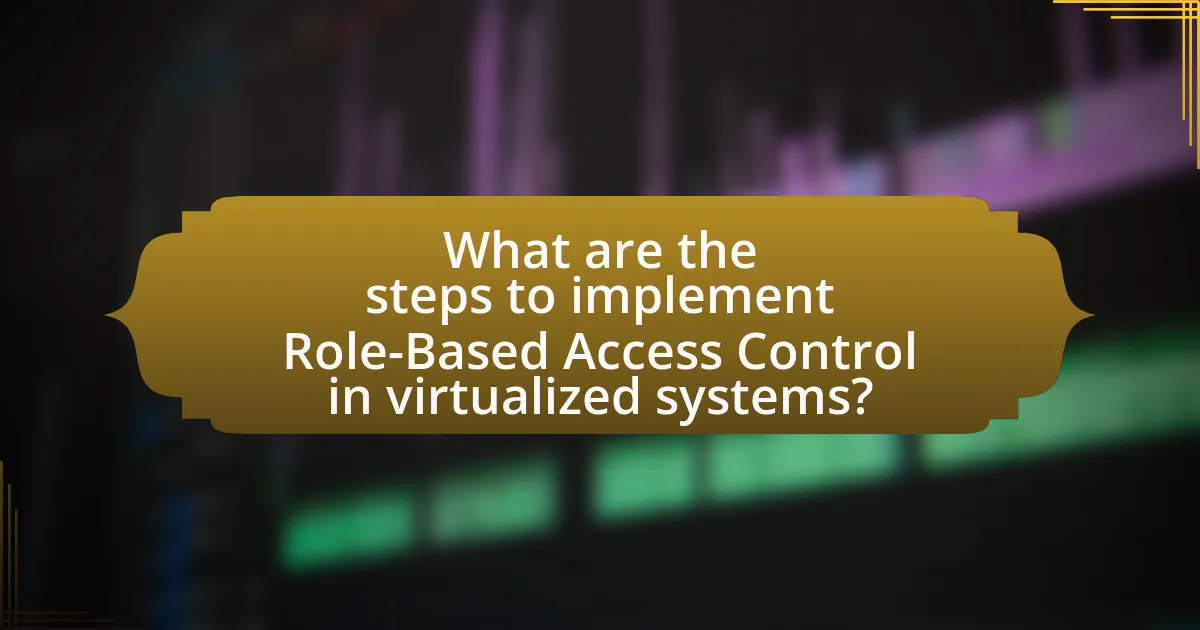Role-Based Access Control (RBAC) is a critical security mechanism in virtualized systems that restricts access to authorized users based on their defined roles within an organization. This article outlines the functioning of RBAC, its key components, and its importance in enhancing security and compliance in virtualized environments. It discusses the steps for implementing RBAC, the tools and technologies that support it, and best practices for maintaining an effective system. Additionally, the article addresses common challenges and strategies for overcoming resistance to change, ensuring that organizations can effectively manage user permissions and safeguard sensitive information.
What is Role-Based Access Control in Virtualized Systems?

Role-Based Access Control (RBAC) in virtualized systems is a security mechanism that restricts system access to authorized users based on their roles within an organization. In this framework, roles are defined according to job responsibilities, and permissions are assigned to these roles rather than to individual users, streamlining the management of user rights. This approach enhances security by ensuring that users can only access resources necessary for their roles, thereby minimizing the risk of unauthorized access or data breaches. Studies have shown that implementing RBAC can significantly reduce administrative overhead and improve compliance with regulatory requirements, making it a preferred choice in managing access in complex virtualized environments.
How does Role-Based Access Control function in virtualized environments?
Role-Based Access Control (RBAC) functions in virtualized environments by assigning permissions to users based on their roles within an organization, thereby controlling access to virtual resources. In these environments, administrators define roles that correspond to job functions, and each role is granted specific permissions to access virtual machines, storage, and networks. This structured approach enhances security by ensuring that users can only access the resources necessary for their roles, minimizing the risk of unauthorized access.
For instance, in a cloud computing environment, an IT administrator may have full access to all virtual resources, while a developer may only have access to specific development environments. This role assignment is typically managed through centralized access control systems that integrate with virtualization platforms, allowing for efficient management of user permissions across multiple virtual instances. The implementation of RBAC in virtualized environments not only streamlines access management but also complies with regulatory requirements by providing an auditable trail of user access and actions.
What are the key components of Role-Based Access Control?
The key components of Role-Based Access Control (RBAC) are roles, permissions, users, and sessions. Roles define a set of permissions that determine what actions users can perform within a system. Permissions are the specific rights or access levels granted to roles, allowing actions such as read, write, or execute. Users are individuals or entities assigned to roles, thereby inheriting the associated permissions. Sessions represent the active instances of user-role assignments, enabling dynamic access control based on user activity. These components work together to enforce security policies and manage access efficiently in various systems, including virtualized environments.
How do roles and permissions interact within this framework?
Roles and permissions interact within the framework of Role-Based Access Control (RBAC) by defining what actions users can perform based on their assigned roles. In this system, roles are collections of permissions that dictate access levels to resources, ensuring that users can only perform actions relevant to their responsibilities. For instance, an administrator role may have permissions to modify system settings, while a user role may only have permissions to view data. This structured approach enhances security and simplifies management by allowing administrators to assign or revoke access based on roles rather than individual user permissions, thereby streamlining the process of access control in virtualized systems.
Why is Role-Based Access Control important for virtualized systems?
Role-Based Access Control (RBAC) is important for virtualized systems because it enhances security by ensuring that users have access only to the resources necessary for their roles. This minimizes the risk of unauthorized access and potential data breaches, which are critical in environments where multiple virtual machines and applications coexist. According to a study by the National Institute of Standards and Technology (NIST), implementing RBAC can significantly reduce the attack surface by limiting user permissions based on their job functions, thereby promoting a principle of least privilege. This structured approach not only safeguards sensitive information but also simplifies compliance with regulatory requirements, making RBAC a vital component in the management of virtualized systems.
What security challenges does Role-Based Access Control address?
Role-Based Access Control (RBAC) addresses several security challenges, including unauthorized access, data breaches, and compliance violations. By assigning permissions based on user roles rather than individual identities, RBAC minimizes the risk of users gaining access to sensitive information they do not need for their job functions. This structured approach helps organizations enforce the principle of least privilege, ensuring that users have only the access necessary to perform their duties. Furthermore, RBAC simplifies the management of user permissions, making it easier to audit access controls and maintain compliance with regulations such as GDPR and HIPAA.
How does it enhance compliance and governance in virtualized environments?
Role-Based Access Control (RBAC) enhances compliance and governance in virtualized environments by ensuring that only authorized users have access to specific resources based on their roles. This structured access management minimizes the risk of unauthorized access and data breaches, which is critical for meeting regulatory requirements such as GDPR and HIPAA. By implementing RBAC, organizations can maintain detailed audit trails that document user activities, thereby facilitating compliance audits and demonstrating adherence to governance policies. Additionally, RBAC simplifies the management of user permissions, allowing for quicker adjustments in response to changing compliance mandates or organizational policies, ultimately strengthening the overall security posture of virtualized systems.
What are the common use cases for Role-Based Access Control in virtualization?
Role-Based Access Control (RBAC) in virtualization is commonly used to manage user permissions and enhance security. Key use cases include restricting access to sensitive virtual machines based on user roles, enabling granular control over administrative tasks such as provisioning and decommissioning resources, and ensuring compliance with regulatory requirements by limiting data access to authorized personnel only. These applications of RBAC help organizations mitigate risks associated with unauthorized access and streamline operational efficiency in virtualized environments.
Which industries benefit most from implementing Role-Based Access Control?
Industries that benefit most from implementing Role-Based Access Control (RBAC) include healthcare, finance, government, and education. In healthcare, RBAC ensures that only authorized personnel can access sensitive patient information, thereby complying with regulations like HIPAA. In finance, it helps protect sensitive financial data and ensures compliance with regulations such as PCI DSS. Government agencies utilize RBAC to safeguard classified information and manage access to various levels of data. In education, RBAC allows institutions to control access to student records and sensitive information, enhancing data security. These industries leverage RBAC to enhance security, ensure compliance, and manage user permissions effectively.
How do organizations typically implement Role-Based Access Control?
Organizations typically implement Role-Based Access Control (RBAC) by defining roles based on job functions and assigning permissions to those roles. This process begins with identifying the various roles within the organization, such as administrator, user, and guest, and determining the specific access rights required for each role to perform its duties effectively.
Once roles are established, organizations map users to these roles, ensuring that individuals receive access only to the resources necessary for their job functions. This mapping is often facilitated by using an RBAC model that includes role hierarchies, allowing for inheritance of permissions, which simplifies management.
To enforce RBAC, organizations utilize access control systems or software that support RBAC policies, ensuring that access requests are evaluated against the defined roles and permissions. This structured approach not only enhances security by minimizing unnecessary access but also streamlines compliance with regulatory requirements, as it provides clear documentation of access rights and user roles.
What are the steps to implement Role-Based Access Control in virtualized systems?

To implement Role-Based Access Control (RBAC) in virtualized systems, follow these steps: first, define roles based on job functions and responsibilities within the organization. Next, identify the resources and permissions associated with each role, ensuring that access aligns with the principle of least privilege. Then, assign users to the defined roles, ensuring that each user has the appropriate level of access. After that, configure the virtualization platform to enforce the RBAC policies, which may involve setting up access control lists or using built-in RBAC features. Finally, regularly review and audit the roles and permissions to ensure compliance and adjust as necessary based on changes in job functions or organizational structure. These steps are essential for maintaining security and operational efficiency in virtualized environments.
How do you define roles and permissions for users?
Roles and permissions for users are defined by establishing a framework that categorizes users based on their job functions and the access they require to perform their tasks. This involves creating specific roles, such as administrator, editor, or viewer, and assigning permissions that dictate what actions users in those roles can perform, such as read, write, or delete data. For instance, an administrator may have full access to all system functionalities, while a viewer may only have permission to access and read content without making changes. This structured approach ensures that users have the appropriate level of access necessary for their responsibilities, thereby enhancing security and operational efficiency in virtualized systems.
What criteria should be used to create effective roles?
Effective roles in role-based access control (RBAC) should be created based on the principle of least privilege, clear job functions, and organizational needs. The principle of least privilege ensures that users have only the access necessary to perform their tasks, minimizing security risks. Clear job functions help in defining specific responsibilities and access levels required for each role, which aligns with the organizational structure and operational requirements. Additionally, roles should be adaptable to changes in the organization, allowing for scalability and flexibility in access management. These criteria ensure that roles are not only effective in securing resources but also in facilitating efficient operations within virtualized systems.
How can organizations ensure that permissions align with business needs?
Organizations can ensure that permissions align with business needs by implementing a systematic role-based access control (RBAC) framework. This framework involves defining roles based on job functions, assessing the specific access requirements for each role, and regularly reviewing and updating these roles to reflect changes in business processes or organizational structure. For instance, a study by the National Institute of Standards and Technology (NIST) emphasizes that regular audits and assessments of access controls can help maintain alignment with business objectives, ensuring that employees have the necessary permissions to perform their tasks without compromising security.
What tools and technologies support Role-Based Access Control implementation?
Tools and technologies that support Role-Based Access Control (RBAC) implementation include identity and access management (IAM) systems, directory services, and policy management tools. IAM systems like Okta and Microsoft Azure Active Directory provide centralized user management and role assignment capabilities. Directory services such as LDAP (Lightweight Directory Access Protocol) enable the organization of user roles and permissions. Additionally, policy management tools like AWS IAM and Google Cloud IAM facilitate the definition and enforcement of access policies based on user roles. These technologies collectively enhance security and streamline access management in virtualized environments.
Which software solutions are commonly used for Role-Based Access Control?
Common software solutions for Role-Based Access Control (RBAC) include Microsoft Active Directory, Okta, and AWS Identity and Access Management. Microsoft Active Directory provides centralized user management and access control, facilitating RBAC implementation in enterprise environments. Okta offers identity management and access control features that support RBAC across various applications and services. AWS Identity and Access Management enables users to manage access to AWS resources using RBAC principles, allowing for fine-grained permissions based on user roles. These solutions are widely recognized for their effectiveness in managing user access based on defined roles within organizations.
How do these tools integrate with existing virtualized systems?
These tools integrate with existing virtualized systems by utilizing APIs and protocols that facilitate communication between the tools and the virtualization platform. For instance, tools designed for role-based access control (RBAC) can connect to hypervisors and management consoles through RESTful APIs, allowing them to manage user permissions and roles effectively. This integration ensures that access policies are enforced consistently across virtual machines and resources, enhancing security and compliance. Additionally, many of these tools support standard protocols like SAML and LDAP, which further streamline the integration process by enabling single sign-on and centralized user management within the virtualized environment.
What are the best practices for maintaining Role-Based Access Control?
The best practices for maintaining Role-Based Access Control (RBAC) include regularly reviewing and updating roles, implementing the principle of least privilege, and ensuring proper documentation of role assignments. Regular reviews help identify outdated roles or unnecessary permissions, which can mitigate security risks. The principle of least privilege ensures that users have only the access necessary to perform their job functions, reducing the potential for misuse. Proper documentation of role assignments aids in accountability and facilitates audits, ensuring compliance with security policies. These practices collectively enhance the effectiveness and security of RBAC implementations in virtualized systems.
How often should roles and permissions be reviewed and updated?
Roles and permissions should be reviewed and updated at least annually. Regular reviews help ensure that access controls remain aligned with organizational changes, such as employee turnover or changes in job responsibilities. According to the National Institute of Standards and Technology (NIST) guidelines, periodic reviews are essential for maintaining security and compliance, as they help identify and mitigate potential risks associated with outdated or excessive permissions.
What strategies can be employed to monitor access and compliance?
To monitor access and compliance in virtualized systems, organizations can employ strategies such as implementing logging and auditing mechanisms, utilizing access control lists (ACLs), and conducting regular compliance assessments. Logging and auditing mechanisms track user activities and access attempts, providing a detailed record that can be analyzed for unauthorized access or policy violations. Access control lists define permissions for users and roles, ensuring that only authorized individuals can access specific resources. Regular compliance assessments, including vulnerability scans and policy reviews, help identify gaps in access controls and ensure adherence to regulatory requirements. These strategies collectively enhance the security posture and ensure compliance with established access policies.
What challenges might arise during the implementation of Role-Based Access Control?

Challenges during the implementation of Role-Based Access Control (RBAC) include complexity in defining roles, resistance from users, and difficulties in maintaining role hierarchies. Defining roles can be intricate, as organizations must accurately map job functions to specific access levels, which can lead to confusion and misalignment. User resistance often arises due to perceived restrictions on access, making it essential to communicate the benefits of RBAC effectively. Additionally, maintaining role hierarchies can become cumbersome as organizations evolve, requiring ongoing adjustments to ensure that roles remain relevant and effective. These challenges can hinder the successful deployment of RBAC in virtualized systems, impacting security and operational efficiency.
How can organizations overcome resistance to change?
Organizations can overcome resistance to change by actively engaging employees in the change process. This involves clear communication about the reasons for the change, addressing concerns, and providing training to ensure that employees feel competent and supported. Research indicates that organizations that involve employees in decision-making and provide transparent information experience significantly lower resistance levels, as seen in a study published in the Journal of Organizational Change Management, which found that participative change management strategies lead to a 30% increase in employee buy-in.
What training and resources are necessary for successful adoption?
Successful adoption of Role-Based Access Control (RBAC) in virtualized systems requires comprehensive training on RBAC principles and hands-on experience with the specific virtualization technologies in use. Training should include understanding user roles, permissions, and the configuration of access controls within the virtualization environment. Resources necessary for this adoption include detailed documentation, access to training modules or workshops, and support from experienced professionals in the field. Additionally, organizations may benefit from case studies and best practice guides that illustrate successful RBAC implementations, which can provide valuable insights and practical examples for effective deployment.
What are the potential pitfalls in Role-Based Access Control implementation?
The potential pitfalls in Role-Based Access Control (RBAC) implementation include complexity in role management, insufficient role definition, and lack of ongoing maintenance. Complexity arises when organizations have numerous roles, making it difficult to manage permissions effectively. Insufficient role definition can lead to overly broad access, increasing security risks. Additionally, without ongoing maintenance, roles may become outdated, failing to reflect changes in organizational structure or job functions, which can result in unauthorized access. These issues highlight the importance of careful planning and regular review in RBAC systems to ensure security and compliance.
How can misconfigured roles lead to security vulnerabilities?
Misconfigured roles can lead to security vulnerabilities by granting excessive permissions to users, allowing unauthorized access to sensitive data and critical system functions. When roles are not properly defined or assigned, users may gain access to resources that exceed their legitimate needs, increasing the risk of data breaches or malicious activities. For instance, a study by the Ponemon Institute found that 56% of organizations experienced a data breach due to misconfigured access controls, highlighting the significant impact of improper role management on security.
What steps can be taken to avoid common implementation mistakes?
To avoid common implementation mistakes in role-based access control (RBAC) within virtualized systems, organizations should conduct thorough requirements analysis and stakeholder consultations. This ensures that the access control policies align with business needs and user roles. Additionally, implementing a clear and structured RBAC model, such as defining roles based on job functions rather than individual users, minimizes complexity and enhances security. Regularly reviewing and updating access permissions is crucial to adapt to changes in user roles or organizational structure. Furthermore, conducting comprehensive testing of the RBAC implementation can identify potential issues before deployment. These steps are supported by industry best practices, which emphasize the importance of alignment between access controls and organizational objectives to mitigate risks associated with misconfigurations and unauthorized access.
What practical tips can help ensure successful Role-Based Access Control implementation?
To ensure successful Role-Based Access Control (RBAC) implementation, organizations should start by clearly defining roles and responsibilities within the system. This clarity helps in assigning appropriate permissions based on job functions, which is essential for minimizing security risks. Additionally, conducting a thorough analysis of existing access controls and mapping them to the defined roles can identify gaps and redundancies, ensuring that access is granted only to necessary resources. Regularly reviewing and updating roles and permissions is also crucial, as it accommodates changes in personnel and organizational structure, thereby maintaining security integrity. Furthermore, providing training for users on the importance of RBAC and how to adhere to it fosters a culture of security awareness. These practices are supported by industry standards, such as NIST SP 800-162, which emphasizes the importance of role definition and ongoing management in effective RBAC systems.
How can organizations effectively communicate the benefits of Role-Based Access Control?
Organizations can effectively communicate the benefits of Role-Based Access Control (RBAC) by clearly outlining its advantages in enhancing security, improving compliance, and streamlining user management. By presenting specific case studies that demonstrate reduced security breaches and simplified access management processes, organizations can illustrate the practical impact of RBAC. For instance, a study by the National Institute of Standards and Technology (NIST) highlights that implementing RBAC can lead to a 30% reduction in unauthorized access incidents. Additionally, organizations should utilize visual aids, such as infographics, to depict the RBAC framework and its benefits, making the information more accessible and engaging for stakeholders.
What ongoing support is necessary to maintain an effective Role-Based Access Control system?
Ongoing support necessary to maintain an effective Role-Based Access Control (RBAC) system includes regular audits, updates to role definitions, and user training. Regular audits ensure compliance with security policies and help identify any unauthorized access or role misuse. Updating role definitions is crucial as organizational needs evolve, ensuring that access rights remain aligned with current job functions. User training is essential to keep personnel informed about their responsibilities and the importance of adhering to access controls, which helps mitigate risks associated with human error.




